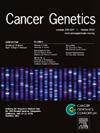Diagnostic and prognostic potential of FBXO8 expression in kidney renal clear cell carcinoma and its regulation of renal adenocarcinoma cells
IF 2.1
4区 医学
Q4 GENETICS & HEREDITY
引用次数: 0
Abstract
Background
The F-box protein 8 Gene (FBXO8) has been shown to suppress invasion and metastasis in various cancer types. Recurrence and drug resistance pose significant challenges in renal cell carcinoma (RCC). Identifying novel biomarkers is crucial for addressing these issues.
Methods
Data on RNA sequencing and patient survival for KIRC was obtained from The Cancer Genome Atlas (TCGA), UALCAN, and Gene Expression Omnibus (GEO) databases. We confirmed FBXO8 gene expression and its impact on survival. Clinical characteristics were classified, and FBXO8 expression differences among various categories were observed. We conducted biofunctional predictions and analyzed the tumor microenvironment (TME), immune cell infiltration, and immune checkpoints in relation to FBXO8 expression. FBXO8 was overexpressed using a plasmid, and we assessed Kidney renal clear cell carcinoma (KIRC) cell proliferation, migration, and apoptosis through CCK8, wound healing tests, and western blot analysis.
Results
Our findings revealed decreased FBXO8 expression in KIRC, with patients exhibiting low FBXO8 expression experiencing shorter survival times. The low expression group showed elevated TME immune and estimate scores. Biofunctional analyses indicated that FBXO8 expression was notably linked to drug metabolism cytochrome P450, nutrition disease, receptor-ligand activity, and neuroactive ligand-receptor interaction. Furthermore, we discovered significant correlations between FBXO8 expression and immune cell infiltration, as well as checkpoints such as CD274. Overexpression (OE) of FBXO8 led to a marked reduction in cell proliferation and migration, along with increased apoptosis, as evidenced by apoptosis-related protein expression.
Conclusion
This study demonstrates that FBXO8 serves as a biomarker for KIRC and plays a role in regulating cell proliferation, migration, and apoptosis.
FBXO8在肾透明细胞癌中的表达及其对肾腺癌细胞的调控作用
背景:F-box蛋白8基因(FBXO8)已被证明可抑制多种类型肿瘤的侵袭和转移。复发和耐药是肾细胞癌(RCC)的重要挑战。识别新的生物标志物对于解决这些问题至关重要。方法:从癌症基因组图谱(TCGA)、UALCAN和Gene Expression Omnibus (GEO)数据库中获取KIRC的RNA测序和患者生存率数据。我们证实了FBXO8基因的表达及其对生存的影响。对临床特征进行分类,观察FBXO8在不同类别间的表达差异。我们进行了生物功能预测,并分析了肿瘤微环境(TME)、免疫细胞浸润和免疫检查点与FBXO8表达的关系。利用质粒过表达FBXO8,并通过CCK8、伤口愈合试验和western blot分析评估肾透明细胞癌(KIRC)细胞的增殖、迁移和凋亡。结果:我们的研究结果显示,在KIRC中FBXO8表达降低,FBXO8低表达的患者生存时间较短。低表达组TME免疫评分和估计评分均升高。生物功能分析表明,FBXO8的表达与药物代谢、细胞色素P450、营养疾病、受体-配体活性和神经活性配体-受体相互作用密切相关。此外,我们发现FBXO8表达与免疫细胞浸润以及CD274等检查点之间存在显著相关性。FBXO8的过表达(OE)导致细胞增殖和迁移明显减少,同时凋亡增加,凋亡相关蛋白的表达证明了这一点。结论:本研究表明FBXO8作为KIRC的生物标志物,在调节细胞增殖、迁移和凋亡中发挥作用。
本文章由计算机程序翻译,如有差异,请以英文原文为准。
求助全文
约1分钟内获得全文
求助全文
来源期刊

Cancer Genetics
ONCOLOGY-GENETICS & HEREDITY
CiteScore
3.20
自引率
5.30%
发文量
167
审稿时长
27 days
期刊介绍:
The aim of Cancer Genetics is to publish high quality scientific papers on the cellular, genetic and molecular aspects of cancer, including cancer predisposition and clinical diagnostic applications. Specific areas of interest include descriptions of new chromosomal, molecular or epigenetic alterations in benign and malignant diseases; novel laboratory approaches for identification and characterization of chromosomal rearrangements or genomic alterations in cancer cells; correlation of genetic changes with pathology and clinical presentation; and the molecular genetics of cancer predisposition. To reach a basic science and clinical multidisciplinary audience, we welcome original full-length articles, reviews, meeting summaries, brief reports, and letters to the editor.
 求助内容:
求助内容: 应助结果提醒方式:
应助结果提醒方式:


